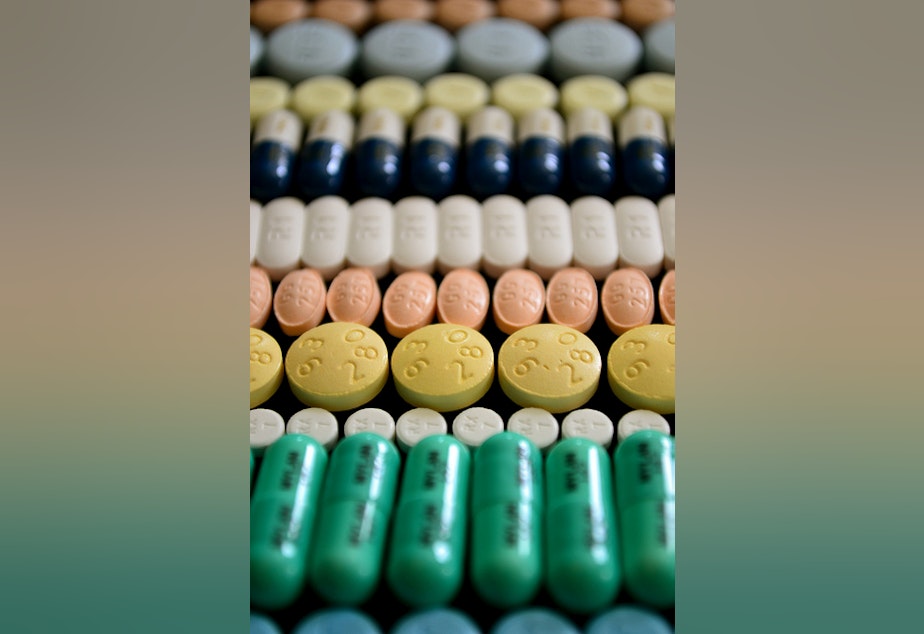Journey Of A Drug: The Long, Hard, Expensive Process Of A New Treatment

From Seattle’s South Lake Union to larger areas like Bothell, biotechnology is a ubiquitous part of the local economy. But moving a drug from research to testing, to market, to patients is an arduous undertaking.“It’s a very long process and drugs can get tripped up at any number of points along the way – sort of like how a bill becomes law,” said Luke Timmerman, national biotech editor of Xconomy, speaking with KUOW’s David Hyde on The Record.
Risky Investment
The journey of a drug begins with investors. Timmerman estimated it takes a drug about 10-15 years from the first clinical trial to FDA approval, and keeping investors interested is key.
That’s no small undertaking.
“It’s still probably too long, and too expensive, and too risky for most people’s liking in the investment community and the medical community,” Timmerman said. “We’d all like to have more confidence that when a drug goes into its first 10 patients, that we have a good sense of whether it’s a good medical advance or not. And the reality is biology is just extremely complicated – there’s a lot we don’t know and those kind of failures still happen.”
Competition can also stop a drug in its track: Over the length of time needed for testing, the standards of care can change.
“Sometimes a company can get all the way through the process and feel like they’ve done everything right, but then a competitor came along and raised the bar,” Timmerman said. “So the FDA will raise the bar and say, ‘A three-month survival improvement is no longer good enough. We need to see six months.’ And that could wreck a drug, destroy a company.”
From Chemist To Patient
A drug starts with a target, such as enhancing the efficacy of a person’s chemotherapy treatment. “Chemists will fiddle around with an atom here, a bond there, to try to make it optimized against that target so it doesn’t hit any other molecular targets like that in the body,” Timmerman said.
Before people are brought in for clinical trials, the drug is tested on animals: mice, rats, dogs, monkeys.
It may take a full five years before the drug is tested on people. Once it passes the animals, it’s time to bring in the FDA for clinical trials, which is done in three phases.
Phase 1: Safety
In the first phase of clinical trials, the goal is to determine the safety of the drug at a variety of levels using “dose escalation.”
“Start low, go slow,” Timmerman said is the motto at this point. If scientists see any toxicity, they can pull the drug before anyone gets seriously harmed.
According to Timmerman, the drug needs to appear safe in one to two-dozen patients before moving on to the second phase. He said most compounds fail in phase one, after relatively little time or money has been spent.
Phase 2: Effectiveness
In this phase, Timmerman said that the process gets more expensive as testing expands to more patients – about 100 – and at more sites around the U.S. The testing period is longer. Patients are randomly assigned to get the new drug or to receive the standard level of care.
Phase 3: Expansion
Once the drug passes the first two phases, testing goes global with about 1,000 patients. Timmerman said that it is still common for drugs to fail in this third stage, even if they previously saw good results. More patients may reveal an unpredicted side effect, or the drug may not be as effective as previously thought.
The Final Script
Once a drug finally gets FDA approval, Timmerman said that it still needs to go through the “delicate dance of drug marketing.”
The company needs to spread the word: get their data published in a reputable, peer-reviewed medical journal; make a splash at a big medical meeting in front of 1,000 cancer doctors; and send a team of sales reps into the field to deliver “elevator pitches” in doctors’ offices.
“Doctors are skeptical people by nature,” Timmerman said. “They want to see really hard, convincing evidence before they’ll change their habits. And then beyond that, they want to see that it actually works and helps their patients.”
But it’s not only the doctors that need convincing. “Beyond that you have insurance companies that are the ones that pay for the drug, so they decide to pay, or not to pay, or how much they want to pay,” Timmerman said.
The nature of the process makes a drug production its own unique market.
“There are a lot of differences in how this capitalistic system works; for one thing, the patient is not really the consumer,” Timmerman said. “The drug company is selling that drug to the physician. The physician makes that key decision on whether to buy or not buy.”
Produced for the Web by Kara McDermott.

